Science & Technology + Art & Design Hybrid Innovation (STADHI)
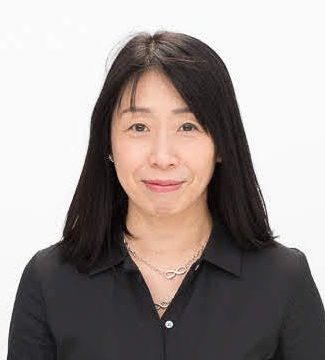
Group Leader Kayoko Nohara
Objective
Through the experimental fusion of science and technology with artistic methods at Tokyo Tech, we will develop new research and technological solutions that reflect on people’s senses, psychology and values, including original art and design works.
For introduction video, click here.
Outcome
- Development of original products and services and publication of art / design works by various research projects that tackle social issues.
- Conceptual modeling of the process that promotes the organic fusion of science and technology with art
Further impact
- Contribution to the practice of STEAM education, which is attracting global attention as an innovative approach in human resource development.
The Tokyo Institute of Technology and University of the Arts London CSM have jointly built a STEAM-type education/human resources development programme (subject module group) which is being applied in settings such as university education, corporate training and lifelong learning support. We will report on the outcomes of these studies and their potential applications in society.
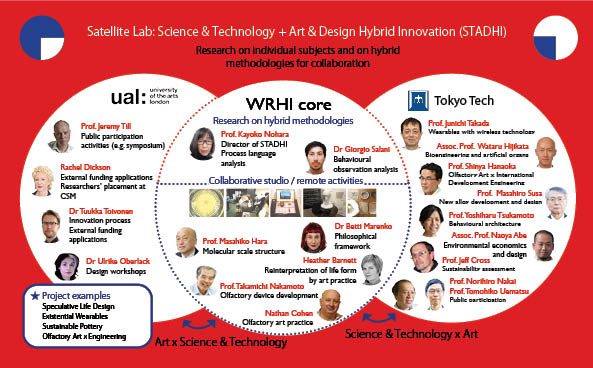
Satellite LaboGroup Nohara
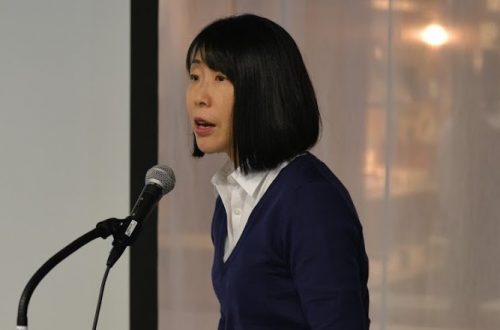
In this era of “post-normal science” (Funtowicz and Ravetz), complex social issues cannot be solved by closed discussions, limited to specific disciplines and cultures within society. A methodology that accommodates uncertainty and noise, re-examines the situation, and asks new questions needs to be developed. This laboratory aims to pursue a space for academic fusion that reconsiders the conceptual mindsets that we researchers have unconsciously and uniformly come to accept. All sciences are at least in some way artistic pursuits. We will explore how the intersection between research, art, and design can be enhanced through unconventional collaborations.
Hybrid process research
Theoretical modelling of a hybrid process that reflects methods and values across art, design, science and technology research.
Subject-specific Research Hubs
Development of wearables
Weather-reflecting clothing, personal space masks, prototypes of communication devices for the elderly.
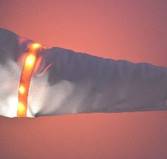
Speculative art/design
Reinterpretation and application of science and technology: molecular scale structure / self-organization / artificial heart etc.

Olfactory device development
Experiment on the effect of incorporating scent into railway stations and cars, leading to products and services.
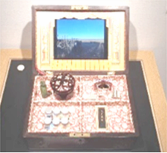
Sustainable pottery research
An interdisciplinary approach (technical / engineering, art / design, sustainability) to propose new pottery manufacturing technologies through material experimentation.
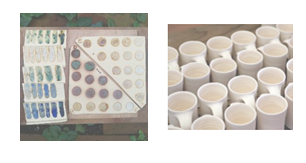
Interview
-
Betti

Can you briefly describe your research at WRHI?
My research articulates a philosophical rationale for transdisciplinarity, fosters critical thinking around technological innovation, and promotes design-led responses to multiple issues arising in the way technology is thought and discussed, in a variety of settings: academic, institutional, research-led, public, student-facing. WRHI is giving me the opportunity to engage with a community of world-class scientists and technologists, and work together at experimenting with, developing, articulating and disseminating an ambitious and innovative transdisciplinary research project. Specifically, with my background in philosophy and social sciences, and my experience of working at the intersection of humanities and design – both in theory and in practice – WRHI offers the ideal platform where I can develop, test and refine new research methods in a broad range of settings. For example, teaching my elective course for postgraduate and PhD students, each bringing their own distinctive expertise and specific field of studies to bear with the topic of the course, curated broadly around how to develop design-led and future-facing instruments and skill sets suitable to reflect critically on science and technology; working alongside Professor Nohara and colleagues (both at TokyoTech and at CSM) to organize outreach and dissemination through public, semi-public and faculty-only events, and industry-tailored workshops; and through our ongoing collaboration towards producing written outputs for peer-reviewed journals (I have one single-authored article at peer-review stage scheduled for publication in early 2021, and another one jointly-authored in development).
What opportunities does this collaboration open up for your research and/or career?
Being involved in collaborative activities with the Nohara Lab and the team has pushed my research into investigating the theoretical rationale for transdisciplinarity, building capacity, expertise and knowledge to scaffold our common research into hybrid methodologies that can capitalize on the encounter between art and design on one side and science and technology on the other, and deploying the humanities as the ‘hinge’ that can connect, engage, articulate and enact such methods in practice. None of this work would have been even conceivable were it not for the collaborative ethos, resources and incredible collegiality found at Tokyo Tech. This collaboration is providing rewarding opportunities not only towards the expansion of my field of research, but towards promoting it across a much wider range of audiences – by showcasing our unique collaborative standpoint that is at once transdisciplinary, transcultural and transnational. The potential reward in terms of career progression are already evident in the current international appetite for a transdisciplinary approach able to address the new post-pandemic normal through building resilience, collaboration and engagement with challenge-driven research.
What do you plan to achieve through this collaboration?
New methods, content and outputs feeding into impactful research dissemination (conferences, publications, paper presentations); knowledge exchange (liaising with industry partners, and the wider public); curriculum and academic development (building resources to create new modules across our two institutions). Transferrable leadership skills. Network-building.
-
Masahiko Hara
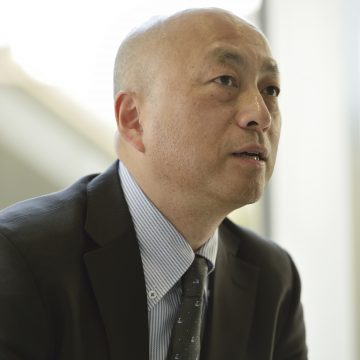
Can you briefly describe your research at WRHI?
My research at WRHI focuses on self-assembly processes in nature, which are studied by high-resolution microscopies and spectroscopies. This involves the fabrication and characterization of novel molecular and materials structures and functions based on nanotechnology. The study of chemical evolution and spatio-temporal dynamics can lead to important findings on the origins of natural intelligence, and the origins of life more broadly. The emergence of a novel social value based on these studies is developed in collaboration with speculative design approaches.
What opportunities does this collaboration open up for your research and/or career?
This collaboration will open up novel approaches in advanced materials and nanotechnology to deliver novel functionality and device architecture, and also a paradigm shift and game change in science and engineering research methodologies to awaken researchers from conventional viewpoints and discussion points.
What do you plan to achieve through this collaboration?
Collaboration with the speculative design scheme will provide novel topologically and dimensionally controlled meta-molecular/materials’ structures and functions to implement novel devices, objects, and media in society.
